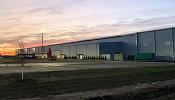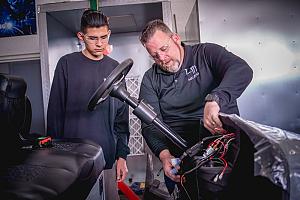- FMA
- The Fabricator
- FABTECH
- Canadian Metalworking
Categories
- Additive Manufacturing
- Aluminum Welding
- Arc Welding
- Assembly and Joining
- Automation and Robotics
- Bending and Forming
- Consumables
- Cutting and Weld Prep
- Electric Vehicles
- En Español
- Finishing
- Hydroforming
- Laser Cutting
- Laser Welding
- Machining
- Manufacturing Software
- Materials Handling
- Metals/Materials
- Oxyfuel Cutting
- Plasma Cutting
- Power Tools
- Punching and Other Holemaking
- Roll Forming
- Safety
- Sawing
- Shearing
- Shop Management
- Testing and Measuring
- Tube and Pipe Fabrication
- Tube and Pipe Production
- Waterjet Cutting
Industry Directory
Webcasts
Podcasts
FAB 40
Advertise
Subscribe
Account Login
Search
Profiling machine eliminates outsourcing requirements for pressure vessel fabricator
- June 1, 2019
- Product Release
- Shop Management
Situation
At RAMA Fabrication and Interstate Treating, 200 to 225 employees are on the job on a given day. The company tackles complete turnkey greenfield construction projects, fabricates entire skids for natural gas processing, and fabricates individual ASME-code pressure vessels from 12 to 120 inches in diameter and 10 to 200 feet long that handle 15 to 1,440 PSI.
The company asserts that it can complete projects in two-thirds the time of any competitor. Rapid growth with that type of customer promise has created opportunities and sometimes problems.
“We outsourced all round-seam and long-seam cylinder cutting, which meant we were at the mercy of suppliers for entire shell sections that required subsequent fabrication steps, such as adding nozzles and base plates,” said Matthew Elrod, Interstate manufacturing supervisor. In addition, those shell sections typically had the longest lead times, which affected the delivery cycle for the entire plant.
The company was using older cutting techniques, which included hand-cutting nozzles with single bevels on cylinders, even when those vessels were 3 or 4 in. thick. These outdated cutting techniques and the requirement for double beveling created limitations, and old welding methods created additional problems.
Because Interstate used subcontractors, most clients required an extensive auditing process to approve and verify that the subcontractors could provide the quality that they demanded. And good welders were simply not easy to find and hire in Texas, an area with plenty of cutting and welding jobs at any given time.
At a time of high production activity, Interstate had a number of projects that were not on the schedule. And many clients were beginning to ask why the fabricator was so far behind.
After investing substantial sums of money into its engineering capabilities, the company realized that it was time to bring its fabrication capabilities into the 21st century as well.
Resolution
Interstate wanted a single source that would provide a variety of cutting capabilities for vessel profiling. It acquired an HGG SPC 3000 profiling machine for cutting and profiling pipes and pressure vessels, along with the HGG vessel head profiling machine for cutting precision beveled holes in pressure vessel heads, shells, nozzles, reinforcing pads, and hillside holes.
“HGG provided us with 3D models and AutoCAD, which helped us design our entire new facility,” said Elrod. “They even helped us streamline machine operations, including head movement, travel, and so on.”
Interstate uses the machine virtually every day to cut and profile pipes from 3/8 to 41/2 in. thick. Machine flexibility enables cutting with oxyfuel or plasma, depending on the job specifics. Thinner walls are cut with plasma for high speed and quality, while thicker walls are cut with oxyfuel. And the machine can be changed over easily during the day from one cutting process to the other.
“With [the SPC 3000], we’ve reduced modeling and layout times by over 20 percent, from five days to one day,” said Elrod. “Welders can now count on total accuracy with respect to hole location and sizing, as well as 100 percent beveling accuracy for both X- and K-axis beveling—axis cutting that welders could not even perform before by themselves. It’s also virtually eliminated scrap, as well as other issues that result from the human factor. Welders now can expect perfect fit-up every time, with welding time cut in half.”
Since installation of the machine, the company has experienced a 20 to 25 percent increase in getting vessels produced and out the door. Whereas it used to take five to six days to cut each pressure vessel with a single bevel, the company now cuts each pressure vessel in a single day with both X and K bevels. Interstate calculated that the machine paid for itself within the first 14 months.
Using HGG’s ProCAM software, the company had to make very few changes to integrate the machine into its existing system. It designs most part profiles in its offline engineering offices, and the software enables design engineers to convert offline files into readable files for the machine and then send those files to the shop floor for cutting. The operator simply runs the program. Operators also have the option to make changes on-the-fly and create new part profiles right at the machine.
The machine has increased volume and productivity at Interstate by expediting delivery cycles and changing how the company estimates jobs while eliminating the need for outsourcing the profiling and beveling of pressure vessels. As a result, the company now has the option of setting up its own contract cutting service to become a job shop for other fabricators in the area.
HGG
www.hgg-group.com
subscribe now

The Fabricator is North America's leading magazine for the metal forming and fabricating industry. The magazine delivers the news, technical articles, and case histories that enable fabricators to do their jobs more efficiently. The Fabricator has served the industry since 1970.
start your free subscription- Stay connected from anywhere

Easily access valuable industry resources now with full access to the digital edition of The Fabricator.

Easily access valuable industry resources now with full access to the digital edition of The Welder.

Easily access valuable industry resources now with full access to the digital edition of The Tube and Pipe Journal.
- Podcasting
- Podcast:
- The Fabricator Podcast
- Published:
- 05/14/2024
- Running Time:
- 62:12
Cameron Adams of Laser Precision, a contract metal fabricator in the Chicago area, joins the podcast to talk...
- Trending Articles
A visit to Automate 2024 reveals the future might be now

Why employee-owned companies make sense in manufacturing

What software automation means for custom fabrication

Majestic Steel Arkansas fully operational

Nucor’s weekly steel price announcement continues to rattle markets

- Industry Events
Laser Welding Certificate Course
- May 7 - August 6, 2024
- Farmington Hills, IL
World-Class Roll Forming Workshop
- June 5 - 6, 2024
- Louisville, KY
Advanced Laser Application Workshop
- June 25 - 27, 2024
- Novi, MI
Precision Press Brake Certificate Course
- July 31 - August 1, 2024
- Elgin,

























